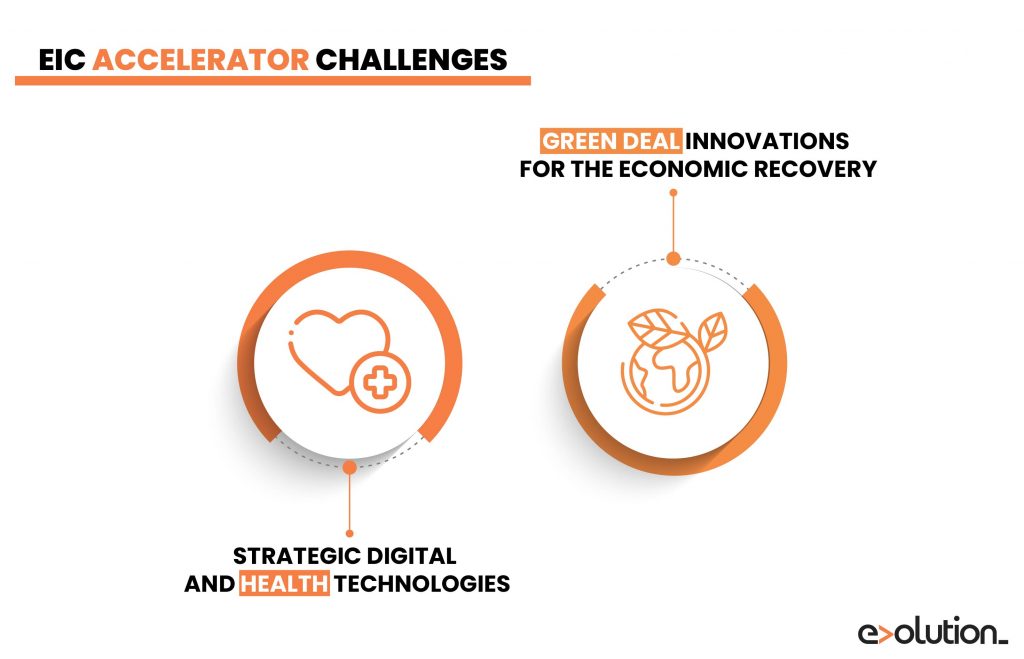EIC Pathfinder, Transition and Accelerator: Which one to choose?

Disclaimer: This post was written a time ago, so some details may have changed since then. We advise you to check out our services page for more information or to contact us directly through this form. Thanks!
Thanks to its funding opportunities, the European Innovation Council (EIC) represents an excellent alternative to mind when fostering our innovative start-up or SME. EIC’s relevance relies on the gained experience of the EIC Accelerator pilot (under the EU Framework Programme Horizon 2020) and the strategic advice of the EIC Pilot Advisory Board.
Although you may be familiar with certain advantages, with the arrival of the new Work Programme some further doubts probably arise. In 2021, three different funding schemes are available: Pathfinder, Transition and Accelerator, each with two separated blueprints (Open and Challenge). These plans of action are non-identical and involve modifications depending on our project characteristics and business goals.
We know deciding which line better suits our initiative can be tricky. For that reason, we decided to explain the main specifications of every funding line to help you make the best decision.
EIC Pathfinder
The EIC Pathfinder option addresses radically new ideas, breakthrough technologies, advanced research and cutting-edge science collaborations. Visionary thinking is welcome under Pathfinder’s umbrella. Applicants usually are scientists, researchers, start-ups or high-tech SMEs with a common goal: initiatives with the potential to create new markets and meet global challenges.
These innovative projects should be in early-stage development, specifically with low Technology Readiness Levels (TRL), between levels 1 and 4. In this way, thanks to Pathfinders’ grant, applicants could achieve the proof of principle and validate their scientific basis.
According to fields or sectors, Pathfinder advocates for interdisciplinary research. Different areas working together usually attract more creative solutions and professionals who may improve the project.

EIC Pathfinder Open
One of the most attractive Pathfinder Open’s characteristics is the budget, as most of the funds allocated to the Pathfinder funding scheme belongs to this category, with €168 million.
Pathfinder Open can fund 100% of eligible costs, considering a contribution of up to €3 million as pertinent. However, if your project needs a more significant amount, you can request more funds by justifying it correctly.
Also, your initiative may receive up to €50,000 to undertake complementary activities to explore more commercialisation options. Your project has the chance to be submitted via the Fast Track Scheme as well.
According to the kind of collaboration, the coordinator should submit proposals on behalf of at least three independent legal entities. These could be Universities, research organisations, SMEs, start-ups, industrial partners, or natural persons. They should be all established in different EU member states or associated countries.
Applicants for Pathfinder open should know the deadline is set on May 19th, 2021. The submitting process is straightforward, as it is a single-step procedure through a 17-page proposal. After submitting, results will be announced five months later, and the grant agreement will take place by eight months after the deadline.
EIC Pathfinder Challenges
EIC Pathfinder Challenge presents some essential differences with the Open funding category. Even the funding rate and the funds for complementary activities are similar to Pathfinder Open’s, the Challenges’ total budget is lower (€132 million). However, the contribution to cover eligible costs rises to €4 million.
Collaborative projects are welcome too, but single candidates and small consortia (two partners) also can have their place with this option.
EIC Pathfinder Challenges has established specific goals, so if your idea tries to answer one of the 2021 challenges, this call may be for you.
- Awareness inside: For projects developing new concepts of awareness applicable to non-human systems.
- Tools to measure & stimulate activity in brain tissue: To better treat brain diseases, the EIC would promote neurotechnology initiatives under this challenge.
- Emerging Technologies in Cell & Gene Therapy: Those initiatives that develop advanced clinical products, improve therapies and try to low risk gene and cell delivery systems will have a place in this challenge.
- Novel routes to green hydrogen production: Decarbonisation is one of main Europe’s 2050 climate goals. To better achieve this objective, Pathfinder Challenge supports novel processes and technologies to produce Green H2.
- Engineered living material: Under this challenge, the EIC seeks to develop new technologies to produce engineered living materials.
In this case, the process varies from the EIC Open, as it is a two-step evaluation procedure with a 25-page proposal. It is important to remember that the deadline will be on October 27th, 2021.

EIC Transition
EIC Transition focuses on innovation, technologies and business plans for specific applications beyond the proof of principle, with grants of up to €2.5 million (or more if adequately justified).
It supports the maturation and validation of novelties in laboratories and application environments (such as prototyping, formulation or model tests). In this way, projects in EIC Transition involve initiatives between Technology Readiness Levels 3 to 6.
The future plans for commercialisation and business modelling also have been taken into account in EIC Transition, as presented activities must be conceived to market readiness.
The 2021 EIC Transition is open to the following eligible initiatives:
- Pathfinder / FET / ERC formerly-funded projects.
- European Research Council (ERC) Proof of concept projects.
There’s no obligation to be a participant, Principle Investigator or result owner of the previous project. But you must be the Intellectual Property Rights holder or owner or, at least, have the necessary rights to commercialise the results of the initiative.
A single entity or a small consortium of two to five partners can apply for Transition. These entities could be, for example, Universities, research organisations, SMEs, industrial partners, or even potential end-users.
Applicants to this line should submit their projects before September 22nd, 2021. Nine weeks after the deadline, the result of the evaluation will be received. An EIC jury will invite participants to a face to face interview if their proposal successfully moves on to the next step.

Even if EIC Transition Open and Challenges share all these characteristics, you should still know some crucial differences.
EIC Transition Open
For this €59.6 million call, there are no predefined thematic priorities. In this way, an initiative representing a scientific, technological, sectoral novel or application may participate in EIC Transition Open.
EIC Transition Challenges
The total indicative budget for this call is €40.5 million, and it is expected to be funded by the Next Generation EU. The main reason for this decision is that this call contributes to achieving a greener, more digital and resilient Europe.
The specific objectives defined for EIC Transition Challenges are:
- Medical Technology and Devices: from Lab to Patient: This challenge targets any technology to benefit clinical treatment and patients’ care, supporting clinicians.
- Energy harvesting and storage technologies: This objective pursues more efficient, low cost and green technologies for sustainable energy harvesting, conversion and storage.

EIC Accelerator
In contrast to the other funding schemes, EIC Accelerator (previously known as SME Instrument) supports SMEs and start-ups to scale up and commercialise their innovations. For that reason, those organisations with the potential to develop new markets or disrupt the existing ones will have a significant funding opportunity applying for this programme. Hence, EIC Accelerator acts as a catalyst to attract other external investors to scale up projects.
This drive to commercialisation places the EIC Accelerator focus on innovation and technology breakthroughs, focusing on deep tech initiatives. Although all fields are included, EIC Accelerator funds technologies at later stages on Technology Readiness Level, 5-6 or higher.
To apply to EIC Accelerator, you must meet one of the following criteria:
- A single applicant from an SME or a “small mid-cap” from a Member State or associated country.
- One or more natural persons or legal entities from a Member State associated or non-associated country intending to establish, invest or relocate an SME or “small mid-cap”.
EIC Accelerator enables a blended finance formula composed by:
- A grant component for eligible costs incurred during the innovation activities. The total amount should not exceed €2.5 million. With this alternative, we could cover up to 70% of the eligible costs. It is possible to request the grant component only or grant first.
- An investment component in the form of equity. The investment amount goes from €0.5 to €15 million. This option covers 30% of non-grant funded budget and commercialisation activities (TRL 9), and it is conceived as a rapid scale-up tool.

In this case, applicants have to go through a three-step evaluation process. Firstly, the short application consists of submission of a 3-minutes video pitch, a 10-slides pitch deck and a 5-page form. If you get the GO in this preliminary step, you will have to prepare the full application within the next 12 months by writing the complete proposal. Finally, the best projects will be invited to a 40-minutes face to face interview with the EIC jury.
Regarding the deadline, short applications can be submitted at any time. If successful, you should prepare your full application, having in mind the two 2021 deadline calls: June 16th and October 6th.
EIC Accelerator Open
For EIC Accelerator Open, the European Commission has set a total budget of €592.5 million, of which €143.05 million come from the Next Generation EU funds.
EIC Accelerator Challenges
The budget for EIC Accelerator Challenges is a bit lower: €494.76 million to €496.76 million, of which around €247 million will be funded through Next Generation EU.
In this case, the planned objectives are the following:
- Strategic Digital and Health Technologies: For projects developing high impact technologies or innovations related to digital and health.
- Green Deal innovations for the economic recovery: For those initiatives contributing to Green Deal goals (sustainable development, gas emission reduction, green technologies…).

Three funding schemes: one decision
As you have seen, Pathfinder, Transition and Accelerator have their own particularities and are conceived for specific purposes and stages of your project development.

Analysing and evaluating your initiative expectations and goals would give you some hints about which decision could be better for finding the most suitable European funds.
Despite their differences, we should trust the European Innovation Council strength and experience in boosting start-ups and SMEs. Its successful track record will make our project grow and reach the commercialisation stage easier.
Are you a start-up or an R&D-intensive SME? Not sure which funding scheme would be better for your initiative? Please contact us for a no-cost evaluation with our expert team.

